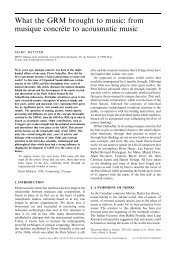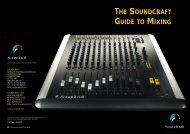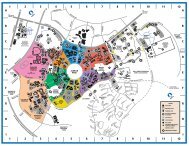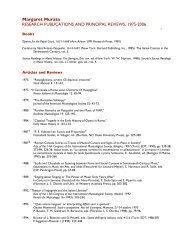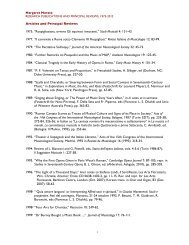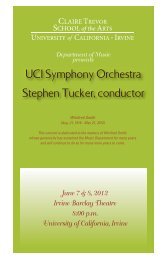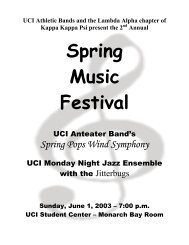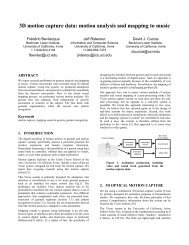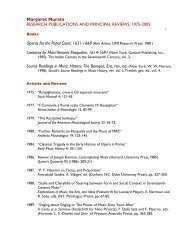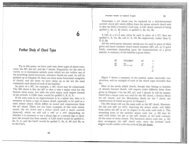âRoots and Branchesâ - Music - University of California, Irvine
âRoots and Branchesâ - Music - University of California, Irvine
âRoots and Branchesâ - Music - University of California, Irvine
You also want an ePaper? Increase the reach of your titles
YUMPU automatically turns print PDFs into web optimized ePapers that Google loves.
• Ground-breaking accomplishments <strong>and</strong> performances (1900 – 1940) include:<br />
1912 – Composer Will Marion Cook publishes A Collection <strong>of</strong> Negro Songs;<br />
1916 – composer Harry T. Burleigh publishes an arrangement <strong>of</strong> the Spiritual Deep River,<br />
thus beginning the development <strong>of</strong> the Art Song Spiritual repertoire;<br />
1917 – Harry T. Burleigh composes the song cycle Passionale (published by G. Ricordi;<br />
1919 – The National Association <strong>of</strong> Negro <strong>Music</strong>ians is founded. Throughout the 20 th<br />
century chapters emerge across the country, <strong>and</strong> the organization becomes an essential<br />
supporter <strong>of</strong> African American singers <strong>and</strong> composers.<br />
1923 - Concert by Rol<strong>and</strong> Hayes, featuring lieder <strong>and</strong> a concluding section <strong>of</strong> Spirituals;<br />
1923 – Paul Robeson stars in All God’s Chillun Got Wings;<br />
April 19, 1925 - concert by Paul Robeson at the Greenwich Village Theatre in New York<br />
City – the first vocal concert to present a repertoire devoted entirely to the Spiritual;<br />
1926 – Quinn Chapel A.M.E. Church <strong>of</strong> Chicago develops the June Rose Concert;<br />
1926 – Hall Johnson composes the art song Mother to Son using the poetry <strong>of</strong> Langston<br />
Hughes;<br />
1926 – Rol<strong>and</strong> Hayes gives a distinguished performance at Carnegie Hall;<br />
1929 – Contralto Marian Anderson gives her debut recital at Carnegie Hall;<br />
April 1931 – Baritone Jules Bledsoe gives his debut recital at Carnegie Hall;<br />
January 31, 1933 – Contralto Etta Moten Barnett performs at the White House;<br />
June 15, 1933 – Rol<strong>and</strong> Hayes performs excerpts from Samuel Coleridge-Taylor’s<br />
Hiawatha’s Wedding Feast at a program presented by the Chicago Symphony Orchestra;<br />
September 1933 – April 1934 – Marian Anderson concertizes throughout Europe (Denmark,<br />
Finl<strong>and</strong>, Norway <strong>and</strong> Sweden);<br />
1934 – Soprano Lillian Evanti performs at the White House<br />
August 1935 – Marian Anderson gives a recital in Salzburg after which conductor Arturo<br />
Toscanini describes her voice as a voice like yours is heard once in a hundred years.<br />
December 30, 1935 – Marian Anderson’s historic New York Town Hall concert;<br />
March 8, 1935 – Dorothy Maynor <strong>and</strong> Todd Duncan perform for Franklin <strong>and</strong> Eleanor<br />
Roosevelt at The White House;<br />
1936 – Marian Anderson gives a private recital at the White House for President <strong>and</strong> Mrs.<br />
Roosevelt;<br />
1937 – Soprano Ruby Elzy performs at The White House;<br />
1939 -- Paul Robeson performs Earl Robinson’s Ballad for Americans(<strong>and</strong> records it in<br />
1940)<br />
April 9, 1939 - Easter Sunday concert by Marian Anderson before 75,000 people at the<br />
Lincoln Memorial<br />
• Opera <strong>and</strong> The Art Song (1900 – 1940)<br />
African American singers <strong>and</strong> composers <strong>of</strong> Art Songs continue to be active within the genre <strong>of</strong><br />
opera. Several singers audition for major American opera companies. They are not hired,<br />
largely because <strong>of</strong> discrimination practices. The African American community responds to the<br />
void, establish ensembles for the performance <strong>of</strong> opera.<br />
Concurrently, African Americans are active in the composition <strong>and</strong> production <strong>of</strong> Creole shows<br />
<strong>and</strong> early 20 th century Broadway musicals. These early shows have not become staples <strong>of</strong> the<br />
repertoire, but songs from them have been preserved <strong>and</strong>, increasingly, are performed. Within<br />
this repertoire, the coon song <strong>of</strong> Ragtime <strong>and</strong> Tin Pan Alley evolves into an artistic show tune <strong>of</strong><br />
the American Song Book. By the end <strong>of</strong> the 20 th century, the songs <strong>of</strong> the American Song Book<br />
form part <strong>of</strong> the Americana art song concert repertoire.



